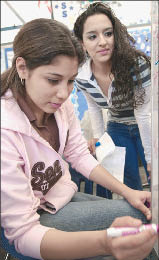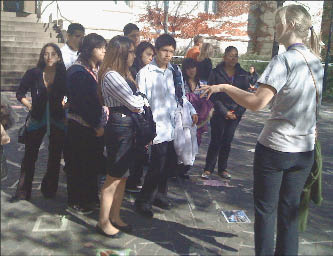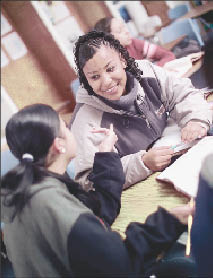 |
|
Tutoring is key. |
Before President Barack Obama plucked him from Chicago to serve as the nation’s new education secretary, Arne Duncan testified before Congress last summer about his public school system’s “winning streak.” The Chicago Public Schools (CPS) chief cited increases in attendance, academic achievement, graduation rates and the number of students going to college – especially poor, minority youths.
While various initiatives get credit for those achievements, when you ask about the increase in college enrollment, you hear one of Duncan’s top aides, a host of researchers, students and a youth organizer who led a school reform movement all cite a college-prep program that Chicago adopted six years ago and that has been steadily expanding.
The nonprofit program is called AVID (Advancement Via Individual Determination), and Chicago’s experience with it offers important lessons for those trying to get more low-income youth on the path to a post-secondary degree.
Meseret Negash, director of programs and partnerships for Scholarship Chicago, a nonprofit that works to improve graduation rates among Chicago area youth, said the AVID students tend to stand out from the rest of the students the group works with. The group took the unusual step of reserving five of the sixty $5,000 scholarships it awards each year specifically for AVID students.
“I find them to be very dynamic and engaged,” Negash said. “The students we work with, their self-determination really shows.”
AVID seeks to challenge and prepare average students – those in the so-called “forgotten middle” – to take more rigorous courses in high school to improve their chances of attending and, more importantly, succeeding in college. Since its inception in San Diego in 1980, AVID has grown to serve 4,000 schools in 45 states and overseas. The nonprofit took in $27.1 million in 2007.
Chicago was the first large urban school district to implement AVID on a large-scale basis. It “definitely made a difference,” said Cindy Cardenas, a DePaul University freshman and a 2008 graduate of Chicago’s North Grand High School, where AVID was implemented school-wide.
Cardenas credits AVID with helping her earn a high school GPA of 3.0, navigate the college application process, and find and win a $2,200 scholarship. She said AVID changed the academic culture among her fellow students and alumni at North Grand.
 |
|
Youths from Kelvyn Park High School visit the campus of Northwestern University. Photo: CPS |
“It motivates students who never even thought about college to go to college,” said Cardenas, speaking on a cell phone while riding the No. 74 bus from DePaul. “Coming from where I came from, a lot of my classmates weren’t even planning on graduating from high school.” AVID “motivated them to see a different way of life.”
Ronald Raglin, district coordinator of AVID for the CPS and an early proponent of establishing the program there, is convinced that the initiative is “at the heart” of Chicago’s success. “The data speaks for itself,” he said.
The story of AVID in Chicago begins in the summer of 2001, in a fifth-floor conference room at the CPS downtown headquarters.
Seeing Hope
It wasn’t an official administrative meeting or anything like that. Raglin, a California schoolteacher at the time, was visiting his native city during the summer break and had gone to see his childhood friend Duncan, who had offered him a pair of tickets to a White Sox game. Duncan was deputy chief of staff at Chicago Public Schools – not the household name he is today.
As Raglin and Duncan talked, the conversation shifted from baseball to something more serious: Mayor Richard Daley was thinking about naming Duncan CEO of the school system. Duncan described himself as a “dark horse,” Raglin recalled, but then asked Raglin, “Do you want to be a part of this team?”
Raglin said he didn’t think he had much to bring to the table. He was a special education teacher in California’s Merced City School District and was serving as the district’s AVID coordinator. But what Raglin didn’t foresee at the time was that the AVID coordinator position had prepared him for the work ahead in Chicago, where he started in September 2002.
At around the same time, Jeremy Lahoud, a youth organizer at a Chicago-based grassroots group called Southwest Youth Collaborative, started tilling the soil for AVID to grow.
Lahoud discovered AVID during a June 2002 trip to San Jose, Calif., where he saw local youths, led by the Californians for Justice Education Fund, protesting cuts in their AVID program. He wanted to know more.
This is what he learned: Youths participating in AVID are offered two special classes as electives. In one, AVID-trained teachers instruct students in various skills to help them succeed in college-prep courses, such as how to use the Cornell note-taking system, and how to ask questions that go beyond simply who did what – questions that involve evaluating, imagining, extrapolating and generalizing. Students are required to keep class notes and assignment lists organized in a thick, three-ring binder.
In the second class, the students get help in core academic subjects from college students who are trained in AVID’s “tutorology.” The tutors also model how to form study groups, so students can do the same in college.
“The most important part is reaching out to students and making a connection with them,” said Jaclyn Smith, 23, an English major at DePaul University and part-time AVID tutor. “When they know someone cares about what they’re doing, somebody cares about their work, they push themselves harder.”
With these academic supports in place, the youths take more rigorous courses – such as Advanced Placement, International Baccalaureate and honors classes – to prepare them for the academic demands of college. Some schools offer one or a few AVID classes to selected students; others implement the program school-wide.
Teachers who volunteer to be AVID instructors form site teams, which meet monthly to help coordinate the program. Students and parents sign pledges to do what it takes to make their AVID experience successful.
Lahoud recalled that after he learned the basics about AVID, he wanted to know: “How come it doesn’t exist in Chicago?”
 |
| More Tutoring. Photo: AVID |
Getting Started
Back home, Lahoud began grooming members of Generation Y, a youth activist organization within the Southwest Youth Collaborative, to press school officials to adopt AVID. The students helped prepare a report, released in October 2002, called Higher Learning: A Report on Educational Inequities and Opportunities Facing Public High School Students in Chicago.
Among other things, the report claimed that black and Latino students were “denied equal access to college prep classes,” and consequently steered away from college and toward the military. It called for CPS to adopt AVID at 10 high schools where minority students were underrepresented in college prep courses.
While Lahoud’s efforts were instrumental in persuading school officials to adopt AVID, Lahoud said its actual implementation “moved quickly because [Raglin] was in leadership in the district and had been an AVID teacher in California.” (Lahoud now serves as executive director of the Californians for Justice Education Fund in San Jose – the group that led him to discover AVID.)
In 2003, Raglin and several Chicago teachers attended AVID’s summer training institute in Atlanta. That fall, Chicago started AVID in eight high schools.
Today, AVID, housed in CPS’ Department of College and Career Preparation, is in 59 high schools and 191 K-8 schools. That’s nearly half of its high schools and nearly one-third of its elementary schools. The school district spends $3.35 million a year on the program, serving 50,000 students – a cost of about $67 per student each year.
During the early years, 90 percent of AVID’s funding came from grants, including from the Dell Foundation, according to CPS; today, it all comes from the school system itself.
Does it Help?
Duncan did not cite AVID when he spoke last summer to the U.S. House Committee on Education and Labor, but he has publicly praised the program.
“AVID inspires kids to push themselves,” Duncan said at a 2005 news conference with Mayor Daley to push for better state funding for the city’s public schools. “The kids involved have higher test scores and higher attendance. We’d like to double the number of schools in the program next year.”
A 2007 report by the Consortium on Chicago School Research at the University of Chicago described AVID as a “key piece of its [CPS’] high school reform strategy.”
The report found that most AVID participants (about 70 percent of low-performing students and 97 percent of high-performing students) believed the program helped them succeed in high school and prepared them for college. Most (57 percent of low-performing students and 96 percent of high-performing students) indicated that they looked forward to going to their AVID tutorial class each day. Half of low-performing students and 92 percent of high-performing students said they would recommend AVID to their friends. Average students typically fell somewhere in between the two groups in their views of AVID.
The deeper question is: How do AVID graduates do in college? And where will they land afterward?
“We’re actually tracking the AVID students that started coming in this fall,” said Brian Spittle, assistant vice president for access and attainment at DePaul University, which courts AVID students by hosting college tours and the like. Preliminary findings of the DePaul study are expected early next year.
Nationally, there has been little research on the performance of AVID students in college. A 2000 report by the California-based Center for Research, Evaluation and Training in Education concluded that “AVID positions students well for life after high school.”
“The vast majority of survey respondents (nearly 95 percent) were enrolled in a college or university,” according to the study, Longitudinal Research on AVID, 1999-2000. More than half had an “A” or “B” average.
In terms of college enrollment, Chicago students who participated in AVID are achieving similar results. According to figures provided by Raglin, in 2007 Chicago’s AVID students:
• Enrolled in college at a rate of 68.7 percent, compared with 50 percent for CPS as a whole.
• Enrolled in four-year institutions at a rate of 75.6 percent, compared with a CPS average of 68 percent.
• Earned GPAs of between 2.0 and 3.4 at a rate of 70.4 percent, compared with 57.3 percent of CPS students overall.
In 2006, Chicago saw the first class of AVID students graduate from high school. Of the 91 students who participated in AVID for its first three years, 61 percent are in college, compared with 47.9 percent of all CPS graduates.
Raglin notes that the district’s overall averages would be lower if not for the inclusion of AVID participants.
Not all statistics suggest AVID students do better than others. For example, 65.8 percent of AVID students scored less than a 17 on their ACTs, as opposed to only 40 percent of the rest of the district’s students. Even colleges with liberal admission policies prefer students with ACT scores of at least 18, according to ACT.
“In general, a student that scores below an 18 is likely not proficient in many academic skills they would need to succeed in college,” said ACT spokesman Ed Colby.
Colby added, “It makes perfect sense to me that AVID students would have a lower overall ACT score, because they’re included in that program because they’re underachieving and disadvantaged.”
Raglin said that considering Chicago’s success with AVID, he wouldn’t be surprised if the program spreads, now that Duncan is education secretary.
But Jim Nelson, AVID’s executive director, attributes the program’s growth to its own successes. “We’re very pleased that someone who knows AVID and is supportive of our work is in that role,” Nelson said, referring to Duncan. But, he said, “We grow because what we do works.”





























